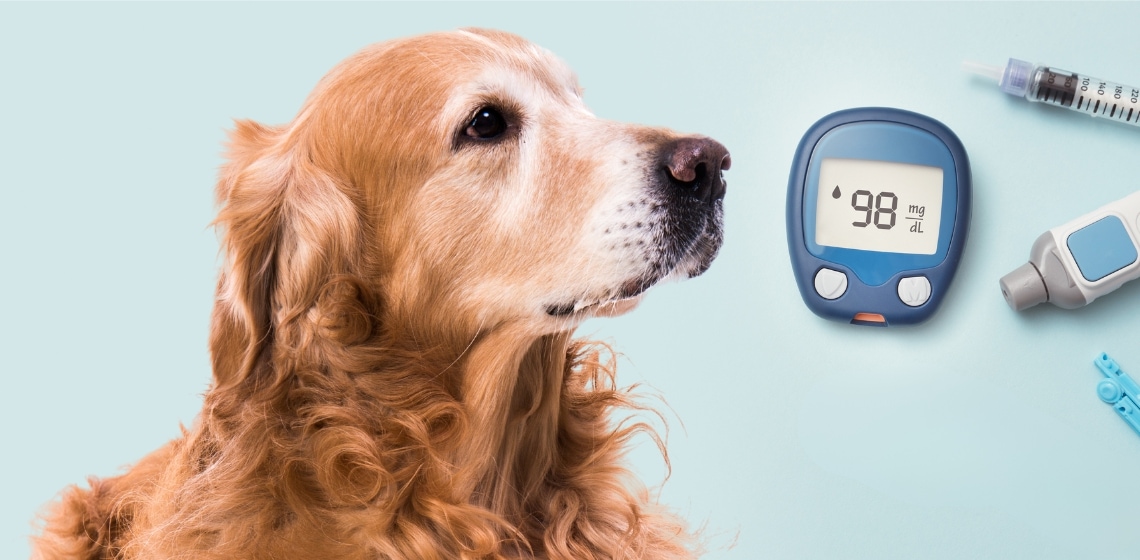Table of Contents
What is Diabetes?
Diabetes is a health condition that affects how your pet’s body uses glucose (a sugar), which is a crucial source of energy for their cells. In a healthy pet, the pancreas produces insulin, a hormone that helps cells absorb glucose from the bloodstream. In diabetic pets, this process is disrupted, leading to elevated blood sugar levels and the characteristic symptoms of diabetes.
In Dogs
Dogs primarily suffer from a condition similar to human Type 1 diabetes. This means their pancreas does not produce enough insulin. Without insulin, their bodies cannot properly use glucose for energy, leading to high blood sugar levels. Lifelong insulin injections are vital for managing diabetes in dogs.
In Cats
Cats often experience a condition similar to Type 2 diabetes in humans. Their bodies might still make insulin, but their cells do not respond to it as effectively as they should. This resistance to insulin leads to elevated blood sugar. While insulin injections are the most common treatment for diabetes in cats, diet is also extremely important. With prompt and aggressive treatment, some cats can achieve remission, which means they temporarily or permanently regain the ability to use insulin properly, reducing or eliminating the need for additional insulin.
Symptoms of Diabetes
Recognizing the symptoms of diabetes in dogs and cats is crucial for early diagnosis and effective management. The symptoms can be subtle at first but become more noticeable as the condition progresses. Here’s what pet parents should look out for:
- Increased Thirst and Urination: One of the earliest and most common signs of diabetes is an increase in thirst and urination, also known as polyuria/polydipsia. Pets may drink more water than usual and need to urinate more frequently, sometimes having accidents in the house.
- Weight Loss Despite a Normal or Increased Appetite: Even though a diabetic pet may eat more than usual, they may still lose weight. This happens because their bodies cannot efficiently convert food into energy due to insufficient insulin.
- Cloudy Eyes: Diabetes can lead to cataracts, which make the eyes look cloudy or opaque and can affect vision, especially in dogs.
- Recurrent Infections: High blood sugar levels can make diabetic pets more susceptible to infections, particularly urinary tract infections.
- Other Signs of Illness: Lethargy, vomiting, diarrhea, loss of appetite, and depression can be signs of a life-threatening complication of diabetes known as diabetic ketoacidosis (DKA).
What Causes Diabetes in Dogs and Cats?
Diabetes in dogs and cats can arise from a combination of genetics, lifestyle, and other factors. In dogs, diabetes is often linked to a genetic predisposition, meaning certain breeds are more at risk for developing the condition. For both dogs and cats, obesity is a significant risk factor. Other contributing factors include age and underlying medical conditions, such as pancreatitis or hormonal imbalances.
Diagnosis of Diabetes
Diabetes is generally diagnosed based on clinical signs and evidence of high levels of glucose in your pet’s blood and urine. Your vet may also recommend additional tests to confirm the diagnosis and rule out other possible causes.
- Blood Tests: Blood tests are crucial for diagnosing diabetes. They measure your pet’s blood glucose (sugar) levels. A persistently high blood glucose level (hyperglycemia) is a primary indicator of diabetes. In some cases mild hyperglycemia may also be due to stress, medications, or other disease processes, and your vet will need to differentiate this.
- Urine Tests: Alongside blood tests, urine tests are needed to check for the presence of glucose and ketones in the urine. In healthy animals, glucose is not usually found in urine, but in diabetic pets, the high level of glucose in the blood leads to glucose spilling into the urine. A urine culture is also recommended to check for urinary tract infection, which is often present in diabetic animals.
- Fructosamine Test: This test measures the average blood glucose level over the past two to three weeks. It helps differentiate between temporary glucose level elevations (due to stress, for example) and diabetes.
- Additional Tests: Depending on the pet’s condition, your veterinarian may recommend additional tests to assess for diabetes-related complications or underlying conditions that might have contributed to the development of diabetes.
How is Diabetes Treated?
Treating diabetes in pets includes insulin therapy, dietary management, regular blood glucose monitoring, and lifestyle modifications. The treatment aims to maintain blood sugar levels near a normal range, thus reducing symptoms and preventing complications. While the fundamental approach is similar, the specifics can vary between dogs and cats.
Treating Diabetes in Dogs
- Insulin Injections: Insulin injections are essential in managing diabetes in dogs. The type and dosage of insulin are tailored to each dog’s needs. Your veterinary team will teach you how to store and administer insulin, usually as an injection under the skin twice daily after meals. The needles are very small, and the injections are usually well tolerated.
- Dietary Management: A high-fiber diet is often recommended for diabetic dogs. Fiber helps to slow the absorption of glucose from the digestive tract. Additionally, consistent feeding schedules and portion control are important to prevent blood sugar spikes.
- Exercise: Regular, moderate exercise helps maintain a healthy weight and stabilize blood sugar levels.
- Blood Glucose Monitoring: Regular home monitoring or veterinary check-ups are essential to track blood sugar levels and adjust insulin dosages accordingly.
Treating Diabetes in Cats
- Insulin Therapy: Similar to dogs, insulin injections are a key part of diabetes treatment in cats. The type of insulin and dosing schedule may differ based on the cat’s response and specific needs.
- Dietary Management: Diabetic cats benefit from a high-protein, low-carbohydrate diet, which can help regulate blood sugar levels. Feeding routines and portion sizes should be consistent to help manage diabetes effectively.
- Exercise: Maintaining a healthy weight through daily activity is beneficial.
- Blood Glucose Monitoring: Blood sugar levels should be monitored regularly, either at home or through visits to the vet.
- Remission Possibility: With effective management, some cats may achieve diabetic remission, where they no longer need insulin injections. This requires careful monitoring and ongoing management.
Prognosis and Complications of Diabetes
Diabetes is a serious medical condition, requiring a commitment for treatment and monitoring from pet parents for the remainder of their pet’s life. Once diabetes is well regulated, however, most dogs and cats do extremely well! Nonetheless, there are several possible complications of diabetes, the most common of which include:
- Hypoglycemia (Low Blood Sugar): This can occur if too much insulin is administered or if a pet isn’t eating enough. Symptoms include weakness, lethargy, trembling, seizures, and, in severe cases, loss of consciousness.
- Diabetic Ketoacidosis (DKA): A serious condition that arises in uncontrolled diabetes when the body starts breaking down fats, leading to an accumulation of acids called ketones in the bloodstream. Symptoms include vomiting, dehydration, lethargy, and, in severe cases, coma and death.
- Urinary Tract Infections (UTIs): High blood sugar levels can lead to an increased risk of UTIs, as bacteria thrive in sugary environments. Symptoms may include frequent urination, discomfort while urinating, and blood in the urine.
- Cataracts (in Dogs): Diabetes can cause the lens of the eye to become cloudy, leading to cataracts, which can result in blindness if left untreated. Signs include a change in eye appearance, clumsiness, bumping into things, or reluctance to jump or climb.
- Neuropathy: Diabetic neuropathy is more common in cats and involves nerve damage, leading to weakness, especially in the hind legs. Affected cats may walk with a plantigrade stance (flat footed) and show muscle wasting.

Liza is a veterinarian who graduated from MSU CVM in 2013 and spent five years working in small animal practice. She loved working with dogs and cats and educating owners on all aspects of veterinary medicine, especially animal behavior and dermatology. She has since transitioned to remote work to be able to spend more time at home with her husband, two young kids, and two cats. She is thrilled to be able to combine her passions for veterinary medicine and writing. She is licensed as a veterinarian in Washington State.








